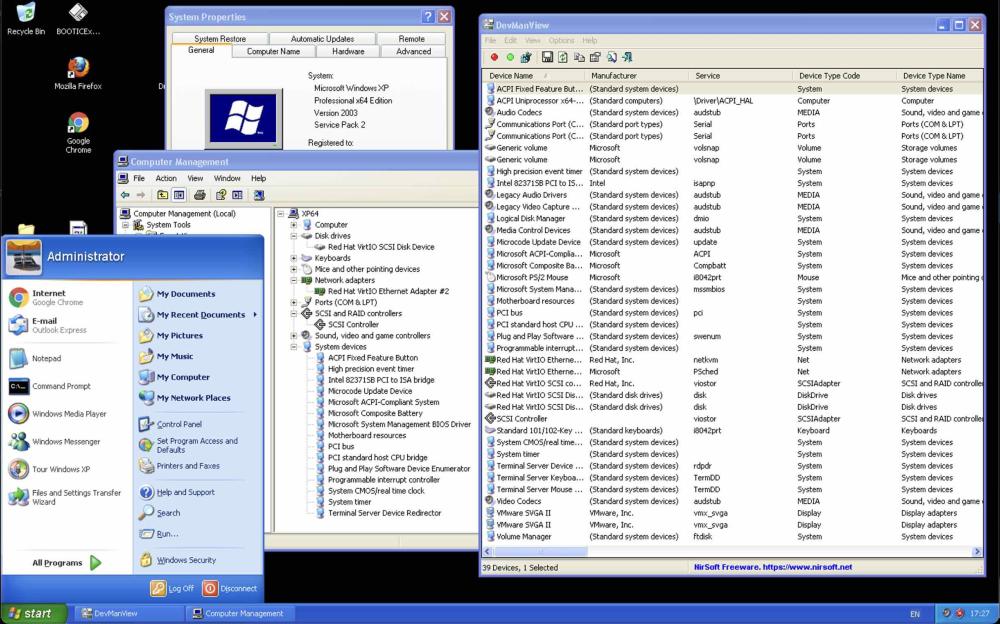Search the Community
Showing results for tags 'uefi'.
-
Can you answer me the following questions: 1. It is possible to get rid of random BSODs when using Windows Vista on AMD Ryzen? 2. It is possible to fix Haswell+ issues on Windows Vista? 3. It is possible to install Windows Vista on UEFI-only PCs by using methods like VgaShim, UefiSeven, disabling VGA method, FlashBoot Pro, etc? 4. Does there is USB 3.0 and NVMe drivers for Vista? 5. Does there is a patched ACPI.sys if you get BSOD 0x000000A5? 6 (optional question). It is possible to add TRIM support into Vista? And last, but not least question: Does there is eMMC drivers for Windows Vista (and Windows 7, because we can't even install Windows 7 on eMMC drives), and if not, it is possible to backport Windows 8 8056 driver to Windows Vista and 7? P.S. For me, the important problems is 1, and 4 (except NVMe because I have 2 SATA drives and no NVMe drives). The optional problems for me is 6 (I have 1 SSD drive and 1 HDD drive, and I would like to install Windows Vista on SSD drive, yes, you can install it on SSD, but Vista does not support TRIM, and I heard that SSD lifespan will be shorter than if you use Windows 7 or newer)
- 13 replies
-
Hi everyone, this is my first post as this forum has been extremely helpful to me to get the Windows XP x64 SP2 running under bhyve on my TrueNAS Core server not wanting to brag but thank to everyone and possibly help someone else that wants to go through similar thing. The process was roughly as follows: Install Windows XP x64 SP2 on Virtualbox (in my case using iSCSI for easier testing on VM Host) with RedHat VirtIO Network driver (booting with ICH6 IDE on ICH9 chipset selection) Install VMWare SVGA II display driver and delete vga.sys and vgapnp.sys with corresponding registry keys, also delete disable emulation registry key and reboot (still legacy) Install Generic_AHCI_1.0 from George King's driver pack Make the installed Windows XP x64 SP2 boot under pure UEFI (using UefiSeven, UEFI:NTFS and AHCI) under Virtualbox with great help of this forum Shutdown virtualbox and boot same VM on bhyve using AHCI driver and 512 byte sector size Fiddle around with cleaning up the unnecessary and nonfunctional drivers (several reboots required) Eventually uninstall too much and break the VM that did not boot anymore. Restore from backup. Repeat. Several times After cleaning up, add one more disk to VM, this time with VirtIO interface. Install VirtIO drivers from RedHat (there is no XP x64 version so i used 2003 64bit version), reboot, possibly two or three times The second disk visible and working under Windows XP x64 SP2, total success Uninstall and remove AHCI drivers, shutdown Remove second disk and set Windows boot disk to VirtIO I intentionally did not write versions and detailed paths to the above, possibly also forgot a step or two, if more details needed ask away There were issues with stability, that now after getting rid of AHCI and with working VirtIO i hope will go away. Still testing. Fingers crossed.
-
- windows xp
- windows xp x64 sp2
-
(and 5 more)
Tagged with:
-
Hi! I just acquired a Lenovo Ideapad 3 with 11th Gen Intel Tiger Lake processor and Intel Iris Xe graphics and I was wondering if it was possible to install Windows 7 to it. Unfortunately, I do not have Legacy Mode so it has to be done in UEFI mode. The ISO I use has all the updates up to 2020 EOL integrated along with drivers such as Nvme, USB3, etc. It also replaces the Win7 PE with the Win8.1 PE (Windows 8.1 was tried first and installs fine). I whip up the USB as GPT in Rufus and put in the UEFI7 1.3.0 files, I install it, boot back into the media, use Shift+F10 to open up command prompt->Diskpart to assign a letter to the System partition and then a command prompt->Notepad->Open->All Files to the Windows 10 part to copy the UEFI7 file to the microsoft/boot folder on the System drive. After exiting, it tries to finish the Windows Logo, but it restarts. When I use "Disable Automatic Restart After System Failure", it simply gets stuck on the incomplete Windows Logo. When I whipped up a Windows 8.0 (6.2) GPT USB, It actually showed me the BSOD, which was NON_ACPI_COMPLIANT_BIOS, meaning this is also most definitely the case for Windows 7. Is there a modded ACPI driver for Windows 7 to get it to run on hardware such as Tiger Lake? Also, has anyone modded graphics drivers that work on Intel Tiger Lake and Windows 7/8.1? And is there any way to get the HID-Compliant touchpad/touchscreen working under 7? Both of these devices do not work under the Windows 7 8 PE nor under 8.1's PE or even an installed copy of 8.1 (the earliest these devices work is with Windows 10 Build 10240, or the free upgrade build given to us in July 2015). Any help on this would be greatly appreciated! I was inspired to start this after seeing the work being put into getting Windows XP to work on modern hardware. Since Windows 7 was the second most popular operating system after XP, I hope this can go somewhere. I would love to use Windows 7 on a 2022 laptop complete with working ACPI, Aero Glass, touchpad, touchscreen, and any other driver I may need (those will be discussed further down the road after we get the four important ones working).
-
First; let me express my gratitude for this great application (Win Toolkit)! I have "always" used RT Se7en Lite / RT7 Lite in the past, but I always had problems with it. Win Toolkit looks and works so much better (as far as I have tested it so far). Secondly; I do have a quick question and though I did use the forum's search function though I couldn't find an answer on my question. I have created an image with all updates and necessary applications (which I needed), removed several things and tweaked it a bit more. Since I don't use (or have) a DVD drive anymore, I will need to use the "USB Boot Preparation"-function from the "Intermediate" menu, so it will make the USB-stick bootable. And next I will copy the contents over. However I have a question regarding this; I have a UEFI enabled / capable BIOS. Will it automatically setup the USB-stick correctly for UEFI installation or should I first make an .iso (through ISO Maker) with "UEFI" / "BIOS and UEFI" option and copy the contents of the created .iso to the USB-stick? I am sorry if it sounds stupid, but I just want to make sure that I am doing everything correctly before I start messing around. Normally I would have just tried it, however I am currently at work (building the image during worktime) and I don't have a USB-stick here. So I cannot test it straight away. Thanks in advance! Highly appreciated.


